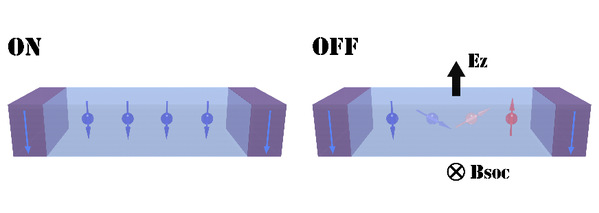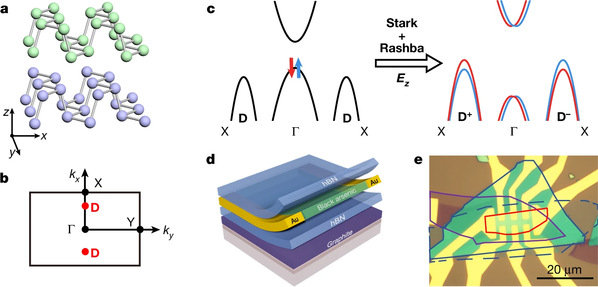Rashba physics has a new “flavor”: ZJU researchers discover high-speed spin switch
Each electron carries one negative elementary charge, whose collective motion generates electric currents that drive the operation of lights, transistors and all kinds of electronic devices. However, as being an elementary particle, electron also possesses an intrinsic angular momentum, i.e. spin of 1/2. It has been a tempting goal to manipulate electron spins for developing faster and more energy-efficient electronic devices since Datta and Das proposed the idea of spin field-effect transistor in the 1990s.

Recently, the research team led by Prof. ZHENG Yi at the Zhejiang University Department of Physics made a major breakthrough. The team demonstrated that synergetic effects between spin-orbit coupling (SOC) and the Stark effect can be activated continuously and reversibly by an external electrostatic gate in centrosymmetric few-layer black arsenic (BAs). Using such an orchestrating effect, they discovered spin-valley-flavored Rashba band formation and unconventional quantum Hall states (QHSs) in the two-dimensional hole gases of BAs for the first time. The study was published in Nature on May 6, entitled “Rashba valleys and quantum Hall states in few-layer black arsenic”.
CMOS technology-based transistors switch on-and-off by controlling current flow in the channels via field effects. However, the collective manipulation of electron spins to form an on-and-off switch is rather challenging, because spin orientations during electron movement can easily be flipped by various scattering mechanisms.
“To develop spin-based electronic devices, we should be first able to manipulate the spin orientation effectively, which would allow us to build spin FETs by controlling spin current flow using spin valves.” ZHENG Yi introduced, “The emergence of novel two-dimensional materials opens enormous opportunities in manipulating electron spins in a fast and efficient manner by the spin-orbit coupling effect. In heavy 2D systems, the orbital motion of conduction electrons in the periodic crystal field is strongly attracted by the positively charged nucleus, producing a relativistic coupling between the electron spin and the direction of orbital motion in the case of inversion symmetry breaking.”
ZHENG Yi et al. found that by introducing an external electric field, the SOC effect in the 2D electronic systems (2DESs) of few-layer black arsenic can be continuously and reversibly switched on and off. This finding in principle provides an efficient way for realizing high-speed spin switch devices by controlling the flow of electron spins using gate-tunable SOC.

Fig.1: Spin FETs based on gate-tunable SOC
As shown in Fig. 1, such gate-tunable SOC-based spin FETs have two ferromagnetic valves with the same magnetization orientation. The injected electrons, spin polarized by the left spin valve, can swiftly pass through the BAs channel without flipping spin orientations in the absence of a gate voltage. Once the external electric field is applied, spin current flow is blocked by the right spin valve due to SOC-induced spin rotation in the BAs channel, thereby fulfilling the function of spin FETs.
In comparison with the silicon-based CMOS transistor, such a spin-based switch is marked by its fast switching speed and low energy consumption. “Researchers can use this gate-tunable SOC effect to control spin flow efficiently and develop prototypical electronic components such as spin FETs in the future.” said ZHENG Yi.

Fig. 2: Flavor-dependent Rashba valley formation in BAs by synergetic Rashba and Stark effects.
In this study, researchers discovered a unique particle–hole asymmetric Rashba band formation in the 2DESs of BAs. For 2D hole gases, they realized gate-tunable Rashba valley manipulations, hallmarked by unconventional even-to-odd transitions in quantum Hall states due to the formation of a flavor-dependent Landau level spectrum.
“It is really thrilling to discover something brand-new when exploring the unknown. We are quite lucky to discover the spin-valley flavored Rashba physics and the related exotic quantization phenomena in BAs, which may become an unprecedented platform for exploring topological quantum computation and for novel spin-based electronics in the future.” said ZHENG Yi.
In their follow-up experiments, researchers are now studying the 2DESs of few-layer BAs in higher magnetic fields, expecting to see more fascinating SOC- and Rashba-related new physics, such as the quantum valley Hall effect and the fractional quantum Hall effect.
More information: Doctoral candidates SHENG Feng, HUA Chenqiang, CHENG Man at the Zhejiang University Department of Physics are the three co-first authors. Prof. ZHENG Yi, who leads the research team, shares the corresponding authorship with Prof. XU Zhu-An from Zhejiang University, and Prof. XIA Qinglin from Central South University.